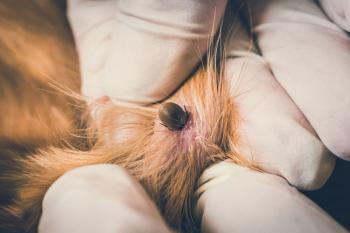
Just Ask the Expert: The zoonotic threat of rabbits and other wild animals
Dr. Kevin Kazacos discusses what zoonotic diseases children can contract from wild rabbit feces and urine.
Dr. Kazacos welcomes parasitology questions from veterinarians and veterinary technicians.
E-mail:
Q. What zoonotic diseases can children contract from wild rabbit feces and urine, such as near the playground at my child's daycare?
Kevin R. Kazacos, DVM, PhD
A. There isn't much risk of contracting a zoonotic disease from wild rabbit feces or urine. Rabbit parasites such as pinworms, other nematodes, tapeworms, and coccidia are host-specific, and since they don't use mammalian intermediate hosts,1,2 they won't be transmitted to other animals, including people. Contracting rabbit fur mites (Cheyletiella species) or ringworm usually requires direct contact with the affected rabbit.1,3 Rabbits also are low on the list of animals that carry bacterial zoonotic agents such as Salmonella species, Escherichia coli, or Campylobacter species,3 although any wild animal feces presents some risk of bacterial disease through accidental fecal-oral infection.
The bacterial zoonoses we usually associate with rabbits, including tularemia and pasteurellosis,3 require direct contact with the rabbit and especially its tissues. In addition, in the case of tularemia, being bitten by a flea or tick carrying the agent or, for pasteurellosis, being bitten or scratched by the rabbit itself is required for transmission.3 Encephalitozoon cuniculi, once considered a microsporidian parasite but now classified as a fungus, is carried by rabbits and produces spores that are sometimes present in their urine.4 However, as much as the agent is transmissible among rabbits, there have been few reported cases in people, and these have occurred in immunodeficient (HIV-infected) individuals, similar to the situation with most other microsporidial infections.4
Probably a greater concern in peridomestic, urban, and suburban environments are areas contaminated with Canada goose droppings, which can be problematic around dwellings and golf course communities with retention ponds. Although their parasites pose little risk because of their host specificity, geese are well-known to carry Salmonella species and other bacteria potentially transmissible to people (through accidental fecal-oral infection) that can cause diarrheal illness.5,6
Carnivores also pose a potential threat to people since their parasites often use mammalian or avian intermediate or paratenic hosts in the life cycle. This would include contact with the feces of raccoons, skunks, coyotes, foxes, and the like, all of which could be present in environments close to people. Raccoon latrines are especially dangerous to children because of the high concentration of eggs of the common roundworm Baylisascaris procyonis; this parasite can cause ocular and neural larva migrans, particularly in children.2,7
With any of these potential zoonoses, common sense precautions go a long way in preventing infection. These precautions include keeping children out of known contaminated areas, closely monitoring infants and toddlers (who are more inclined to orally sample their environment), discouraging pica and geophagia, and encouraging routine hand washing after contact with outside areas or after handling animals.
Kevin R. Kazacos, DVM, PhD, Department of Comparative Parasitology, School of Veterinary Medicine, Purdue University West Lafayette, IN 47907
REFERENCES
1. Bowman DD. Georgis' parasitology for veterinarians. 9th ed. St. Louis, Mo.: Saunders Elsevier, 2009.
2. Samuel WM, Pybus MJ, Kocan AA. Parasitic diseases of wild mammals. 2nd ed. Ames, Iowa: Iowa State University Press, 2001.
3. Williams ES, Barker IK. Infectious diseases of wild mammals. 3rd ed. Ames, Iowa: Iowa State University Press, 2001.
4. Didier ES. Microsporidiosis: an emerging and opportunistic infection in humans and animals. Acta Trop 2005;94(1):61-76.
5. Friend M, Franson JC. Field manual of wildlife diseases: general field procedures and diseases of birds. Madison, Wis.: U.S. Geological Survey Biological Resources Division, National Wildlife Health Lab, 1999.
6. Thomas NJ, Hunter DB, Atkinson CT. Infectious diseases of wild birds. Hoboken, N.J.: Wiley-Blackwell, 2007.
7. Gavin PJ, Kazacos KR, Shulman ST. Baylisascariasis. Clin Microbiol Rev 2005;18(4):703-718.
Newsletter
From exam room tips to practice management insights, get trusted veterinary news delivered straight to your inbox—subscribe to dvm360.




